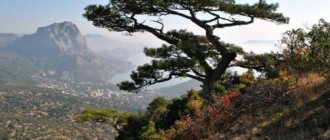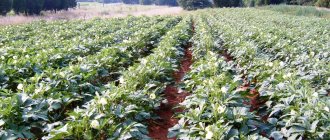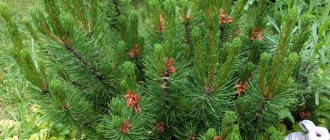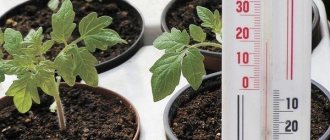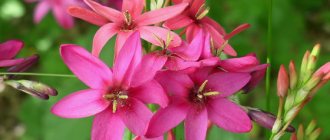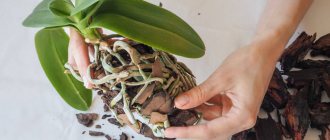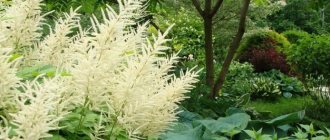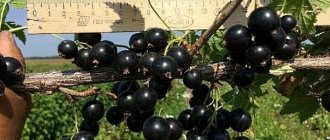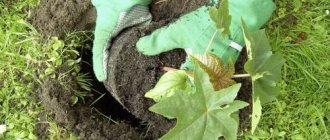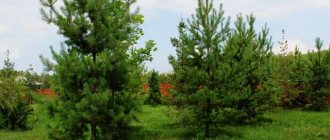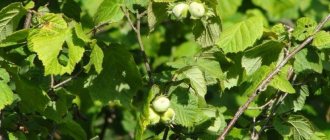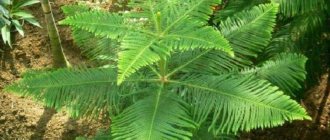» Bushes and trees » Mountain pine Gnome - a slow-growing beauty
0
557
Article rating
Small, compact and very impressive in appearance, the Gnome mountain pine is often used in landscape design. It is unpretentious, tolerates transplantation well, and does not require daily care. Suitable for container plantings and the formation of decorative hedges.
- Landing
- Selection of seedlings
- Preparing the site
- Landing technology
- Care
- Watering
- Top dressing
- Mulching and loosening the soil
- Haircut and trimming
- Preparing for winter
- Reproduction
- Diseases and pests
- Use in landscape design
- Errors during cultivation
- Reviews
Mountain pine Gnome - a slow-growing beauty
Brief information about the variety
- Color : dark green needles;
- Height : up to 2.5 m;
- Crown width : 1.5 m;
- In what regions does it grow : everywhere except the northernmost;
- Planting features : in sunny places, with limited shading, the distance between bushes is at least 1.5 m;
- Immunity : plants need preventive treatments against fungal diseases;
- Life expectancy : 150-200 years.
Pine tree care
Stage 1. Loosening the tree trunk circle
| |
Stage 2. Fertilizing pine
| |
Stage 3. Watering the plant
| |
Stage 4. Pruning and pest control
| |
Stage 5. Covering for the winter
|
Growing regions
In the wild, mountain pine is a multi-stemmed coniferous tree. More than 100 varieties of this conifer are known. They differ in size - from 20 m to 0.5 m in height, appearance and color of needles, but all are unpretentious to environmental conditions.
The shrub grows in the alpine belt of Central and Southern Europe at an altitude of up to 2500 m, on the poorest soils. Able to withstand severe frosts and winds, drought-resistant.
It can be cultivated in all regions of Russia, except the Far North.
Reproduction
Mountain pine can reproduce by seeds. After pollination two years later they are already mature. It is optimal to sow in early spring. first soaked in water for two days. Then sandy loam soil and vermiculite are added to the container, and everything is mixed. Before planting, the soil mixture is disinfected using Fundazol, Fitosporin and other means.
One or two seeds are immersed in the pot and buried slightly into the ground. It is recommended to plant seeds in open ground next spring.
Pine also propagates by cuttings. This method is used in greenhouse conditions. Cuttings are taken from mature trees. It is recommended to plant in April, when the buds are actively swelling. It is advisable to carry out cuttings in the morning when it is cloudy or raining. Cuttings 7–10 cm long are cut with pruning shears and lowered into water , to which Epin extra or Zircon has been added, protecting against possible rotting. To root the cuttings, the soil must be well prepared. Crushed stone and pebbles serve as drainage, and river sand is poured on top. Fertilizers are not used, but for active root formation, special means are sprayed. Roots take 2–5 months to form.
Description of the plant
Gnome pine is an evergreen dwarf shrub, one of the most compact species. Its height reaches 2.5 m, diameter up to 1.5 m, annual growth 7-10 cm. The plant has a spherical crown, which with age, if not formed, becomes dome-like.
The needles are dark green, 4-5 cm long. Brown cones have a round shape, up to 4 cm long. They grow either singly or in bunches, 2-3 pieces. In the first year they are green in color: they mature in the autumn of the second year, becoming brown.
Cones are male and female. The latter have seeds.
Mountain pine has a developed root system that holds the plant on the rocks. In gardens and parks with loose soil, the roots can grow deep. On rocky or heavy soil they are located close to the surface.
Errors during cultivation
There are few of them, since pine is very hardy and unpretentious.
- Excessive pruning and thinning can stop growth.
- When the root collar is deepened, the trunk may rot.
- Thickening of plantings leads to crown deformation and the development of fungal diseases.
- Exposing the roots during planting significantly reduces the chances of normal adaptation.
- Feeding is practically not needed, and in the first 2-3 years it is detrimental to the plant.
- Without shading during the summer months, seedlings can get sunburned.
Landing technology
The planting hole should be larger than the seedling's earthen ball. To fill the hole, a substrate is used, consisting of:
- 1 part humus or compost;
- 1 part sand;
- 2 parts garden soil.
During spring planting, a tablespoon of the complete mineral complex (nitrogen, phosphorus, potassium) is added to this mixture.
It is important that the root collar is at ground level, even after the soil has settled. When the hole is filled, the soil is compacted and watered.
Features of cultivation
To successfully cultivate Gnome pine, you need to choose the right site for the bush. It is recommended to plant in sunny areas that are not prone to flooding. It is advisable to purchase seedlings from a garden center or reserve when they are 3-5 years old with a preserved earthen lump. Younger specimens take root much worse; with exposed roots they often die.
It is recommended to plant in sunny areas that are not prone to flooding.
Growing pine variety Gnome step by step:
- prepare a planting hole;
- purchase a pine seedling;
- plant in accordance with the rules of agricultural technology;
- provide the plant with proper care for the first 2-3 years;
- after 3 years, maintain and, if possible, protect the shrub from adverse factors.
Landing
The optimal time for the operation for container plants is from April to mid-September. The hole is prepared in advance; if you want to grow a hedge, you should dig a trench. Place Gnome shrubs at a distance of 1.5-2 m from each other. The depth and width depend on the size of the earthen ball on the root system; they should be about 2 times larger than it. If the soil is clayey or heavy, you should pour a drainage layer of sand and stones about 20 cm high. Mix garden soil with a small amount of dry humus or phosphorus-potassium fertilizers. If necessary, lighten the structure by adding river sand; coniferous litter from the pine forest will ensure good survival rate.
The optimal time for the operation for container plants is from April to mid-September.
Carefully remove the pine seedling from the container, being careful not to damage the root system or break the lump of earth surrounding it. Lower it into the hole so that the root collar is at the same level. Fill the resulting gaps with soil mixture. Lightly compact the tree trunk circle, forming sides along the edges. Water thoroughly when the water is completely absorbed - mulch the surface with pine needles, sawdust or peat.
Care
Mountain pine requires a lot of attention in the first and second years of growth, while it develops a full-fledged root system.
When planting in spring, seedlings are shaded during the daytime. In the future, work with conifers is reduced to one-time procedures.
Watering
After planting, the plant is watered every 3-4 days for a month; in the summer, crown sprinkling is used. Mature pines do not require watering. Exceptions include long periods of drought and hot weather.
Feeding
In addition to the mineral fertilizer introduced during planting, the next feeding is carried out in the second or third year.
Pine does not tolerate excess organic matter and nitrogen: its appearance and resistance to negative weather conditions suffer.
To eliminate errors, it is recommended to use a complex mineral fertilizer for coniferous species, diluted in water. The solution is applied to the tree trunk after abundant watering.
Mulching and loosening the soil
Pine does not need crown formation
Loosening the soil has several purposes.
- Oxygen access to the roots improves and more favorable conditions appear for the microflora with which the plant lives in symbiosis.
- This creates the opportunity for moisture to penetrate into the deep layers of the soil, and at the same time makes it difficult to evaporate.
- Weeds are being removed.
Mulching the tree trunk circle allows you to save effort and time on weeding, loosening and watering. Coniferous litter is ideal as mulch.
Haircut and trimming
Mountain pine Gnome is a gift for the owner. It does not require regular shaping haircuts. The trunks - semi-lodging and ascending - grow equally up to 10-15 years, as a result of which a spherical crown is formed.
With age, the speed of ascending shoots becomes higher, and the pine becomes dome-shaped.
After winter, sanitary pruning is carried out, removing dry and damaged branches. To give the plant the desired shape and density of the crown, pinching is performed.
It is produced at the beginning of the summer season, when the growth of young shoots (candles) is completed. Using pruning shears, they are shortened by 2-7 cm. After this procedure, several shoots begin to grow at the base of the candles. As a result, the crown becomes more magnificent and dense.
Gradual pruning of branches allows you to obtain a plant of a given shape.
Preparing for winter
The young shoots of the Gnome have time to ripen and become woody during the warm season. In addition, pine has a unique feature - thickened bark at the butt of the trunk. Due to this, it can withstand temperatures down to -35°C.
Only plants with an undeveloped root system close to the soil surface can suffer from frost. For the winter, they are covered with non-woven material, burlap or spruce branches and tied with twine.
In winter, snow poses a danger to conifers, the weight of which causes branches to break.
Reproduction
There are three possible ways:
- seeds;
- cuttings;
- vaccinations.
Vegetative propagation methods (cuttings and grafting) make it possible to preserve all the varietal qualities of the mother plant. But due to their complexity, they are rarely used and only for growing highly decorative varieties.
Rooting cuttings is difficult, long and often unsuccessful (the survival rate is low).
Seed propagation is the easiest way. The seeds ripen by the autumn of the second year. They are sowed in the spring of next year. It is better to sow through seedlings.
Both the planting material and the soil are pre-treated with a fungicide (phytosporin). The seeds are soaked in water for two days, then they are buried in 200 ml containers.
Shoots appear after a month, after which the containers with seedlings are exposed to light. All this time the soil must be kept moist. Planting in open ground is carried out every other year next spring.
Planting a plant
Stage 1. Purchase of planting material
| |
Stage 2. Preparing the soil for seedlings
| |
Stage 3. Preparing the seat
| |
Stage 4. Preparing the seedling
| |
Stage 5. Planting
| |
Stage 6. Watering the seedling
|
Diseases and pests
It is necessary to monitor the health of the tree
Pines, like all conifers, have few enemies in nature. Three main fungal diseases of mountain pine:
- blister rust;
- Schutte fungal disease;
- necrosis of the cortex.
The main drugs to combat infections are fungicides and preparations containing copper. Carriers can be intermediate plants such as currants, gooseberries, and weeds.
Insect pests (aphids, scale insects, sawflies, silkworms, spider mites) can be combated with folk remedies:
- soap solution;
- tobacco infusion;
- tincture of insecticidal plants;
- mechanical collection of pests.
However, the use of modern insecticides is more effective:
- acarin;
- lepidocide;
- decis;
- karbofos;
- actellik.
Use in landscape design
Every year the number of dwarf varieties of mountain pine increases: this happens at the request of landscape designers, who include these plants in a wide variety of compositions.
The dark green needles of the Gnome pine look great in Japanese-style rocky gardens.
Several cones of different sizes attract attention against the backdrop of an evenly trimmed lawn.
To add brightness and expressiveness to a garden with conifers, it is recommended to plant ground cover perennials around the tree:
- saxifrage;
- aubration;
- soapwort;
- splint.
Beautiful compositions of mountain pine with mosses and succulents.
Disease susceptibility
Pine is resistant to diseases and pests. During the growth process, a thick litter is formed, which helps accumulate humus and retain the required amount of moisture. Pine tolerates soil compaction well. Manual crown formation is possible. This type of pine is actively used to create garden bonsai.
Mountain pine Gnome, the description of which was discussed in the article, is an excellent option for landscape design. It looks great as accents near garden paths and large flower arrangements. The plant will delight you all year round.
